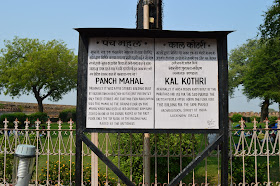Jhansi Fort is one of the significant tourist spot in Jhansi. The phase of this story, the Jhansi Fort was built on a hill by 1613 by Orchha's ruler Raja Bir Singh Deo. The fort has ten doors, some of which stand even at this point. Despite the fact that the old entryways may have vanished, the territories around them are still known by their old names such as Datia Darwaza, Jharna Gate, Orccha Gate etc.There are sanctuaries of Shiva and Ganesha inside. The ruler's guns called Karak Bijli and Bhawani Shankar are still here.
The fortification saw loads of ups and down over the span of history. The fortification was a noteworthy fortress amid the Sepoy uprising of 1857. The rebellion in Jhansi was driven by none other than Lakshmi Bai, prominently called Jhansi ki Rani in the annals of history. Just underneath the dividers as you approach the stronghold, is an odd violence diorama of the fight in which the Rani of Jhansi passed on. In June 1857 when the mutiny arose, a couple of men of the twelfth local infantry grabbed the fortress containing the fortune and magazine, and slaughtered the European officers of the army. The Rani put herself at the leader of the dissidents. In mid 1858, the consolidated armed force of two brilliant Generals of British Arm Force named Lieutenant Walker and General Huroze vanquished Lakshmi Bai. The fortification remaining in the bumpy region indicates how the north Indian style of fortress development varies from that of the south. In the south the vast majority of the strongholds were based on the ocean beds like Bekal Fort in Kerala. The rock dividers of the fortress are somewhere around 16 and 20 feet thick and on the south side meet the city dividers. The south face of the post is practically opposite. There are 10 doors offering access to the fortress. Some of these are Khanderao Gate, Datia Darwaza, Unnao Gate, Jharna Gate, Laxmi Gate, Sagar Gate, Orchha Gate, Sainyar Gate and Chand Gate. Eminent sights in the fortification are the Shiva sanctuary, Ganesh sanctuary at the passage, and the Kadak Bijli gun utilized as a part of the uprising of 1857. The commemoration board helps one to remember the hair-raising accomplishment of the Rani Lakshmibai in hopping on horseback from the fortress. Close-by is the Rani Mahal, worked in the later 50% of the nineteenth century where there is presently an archeological exhibition hall.
The fortress reaches out to a sprawling 15 sections of land (61,000 m2) and this titanic structure measures around 312m long and 225m in width. Overall, there are twenty-two backings with a mammoth reinforcing divider encompassed by a channel on both sides. The smashed upholder on the eastern side was remade by the British, who likewise added a story to Panch Mahal.
Location: Just 2 kilometer from Railway Station
Ideal Time to Visit: Anytime round the year, 9:30 AM to 6:00 PM
Attraction: Design Pattern and Museum
Entry Fees: Indian (Rs.5) Foreign National (Rs.100) Per Head
The fortification saw loads of ups and down over the span of history. The fortification was a noteworthy fortress amid the Sepoy uprising of 1857. The rebellion in Jhansi was driven by none other than Lakshmi Bai, prominently called Jhansi ki Rani in the annals of history. Just underneath the dividers as you approach the stronghold, is an odd violence diorama of the fight in which the Rani of Jhansi passed on. In June 1857 when the mutiny arose, a couple of men of the twelfth local infantry grabbed the fortress containing the fortune and magazine, and slaughtered the European officers of the army. The Rani put herself at the leader of the dissidents. In mid 1858, the consolidated armed force of two brilliant Generals of British Arm Force named Lieutenant Walker and General Huroze vanquished Lakshmi Bai. The fortification remaining in the bumpy region indicates how the north Indian style of fortress development varies from that of the south. In the south the vast majority of the strongholds were based on the ocean beds like Bekal Fort in Kerala. The rock dividers of the fortress are somewhere around 16 and 20 feet thick and on the south side meet the city dividers. The south face of the post is practically opposite. There are 10 doors offering access to the fortress. Some of these are Khanderao Gate, Datia Darwaza, Unnao Gate, Jharna Gate, Laxmi Gate, Sagar Gate, Orchha Gate, Sainyar Gate and Chand Gate. Eminent sights in the fortification are the Shiva sanctuary, Ganesh sanctuary at the passage, and the Kadak Bijli gun utilized as a part of the uprising of 1857. The commemoration board helps one to remember the hair-raising accomplishment of the Rani Lakshmibai in hopping on horseback from the fortress. Close-by is the Rani Mahal, worked in the later 50% of the nineteenth century where there is presently an archeological exhibition hall.
The fortress reaches out to a sprawling 15 sections of land (61,000 m2) and this titanic structure measures around 312m long and 225m in width. Overall, there are twenty-two backings with a mammoth reinforcing divider encompassed by a channel on both sides. The smashed upholder on the eastern side was remade by the British, who likewise added a story to Panch Mahal.
Location: Just 2 kilometer from Railway Station
Ideal Time to Visit: Anytime round the year, 9:30 AM to 6:00 PM
Attraction: Design Pattern and Museum
Entry Fees: Indian (Rs.5) Foreign National (Rs.100) Per Head






























